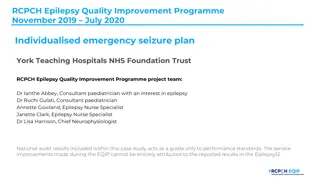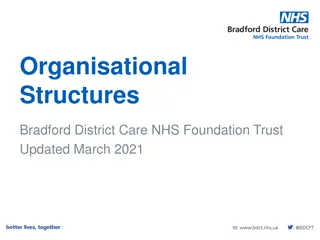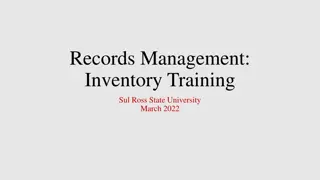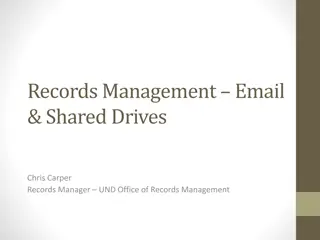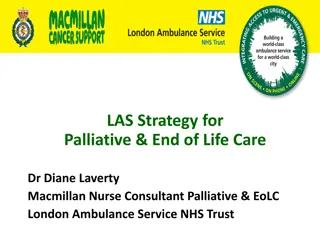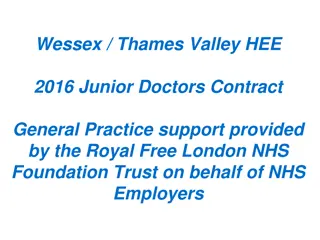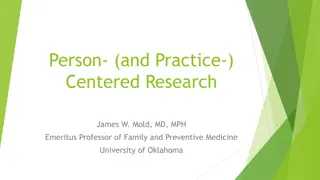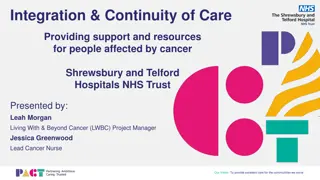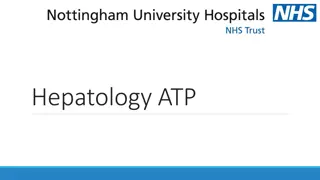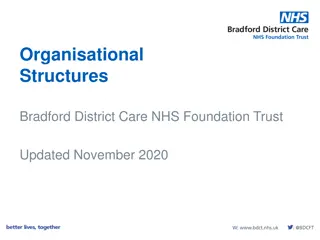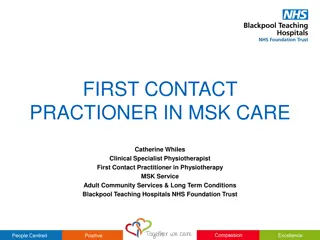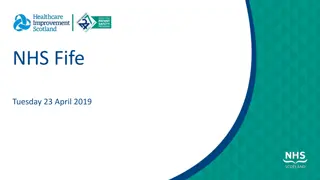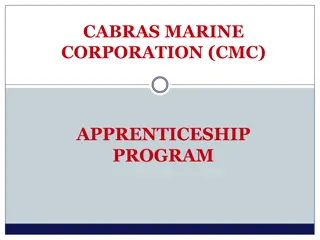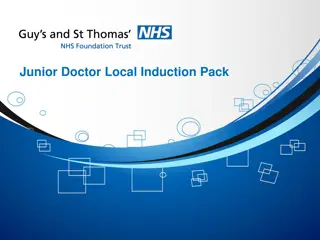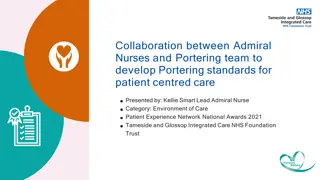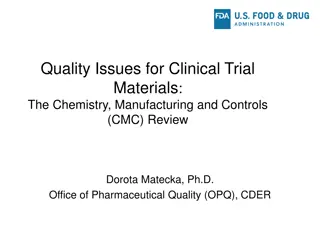Enhancing Patient-Centered Care Through Improved CMC Records at The Hillingdon Hospitals NHS Foundation Trust
The Hillingdon Hospitals Trust aims to enhance patient-centered care by improving visibility and awareness of CMC (Coordinate My Care) records across generic teams through the development of specific patient information resources, tracking patient attendance at ED with CMC records, and optimizing the flow of ACP-relevant information across settings. Initiatives include creating tailored materials, flagging CMC records for ED staff, and supporting medical teams in utilizing CMC records for patient care. The project involves systematic interventions to improve the impact of CMC records on patient outcomes and care quality.
Uploaded on Sep 21, 2024 | 0 Views
Download Presentation

Please find below an Image/Link to download the presentation.
The content on the website is provided AS IS for your information and personal use only. It may not be sold, licensed, or shared on other websites without obtaining consent from the author. Download presentation by click this link. If you encounter any issues during the download, it is possible that the publisher has removed the file from their server.
E N D
Presentation Transcript
Improving the impact of CMC records for patients at The Hillingdon Hospitals NHS Foundation Trust June 2021 L Bunker, M Troup, L Bainbridge, M House, J Potter Hillingdon Hospital, Uxbridge, UK
Background The Hillingdon Hospitals Trust (THH) is an acute and specialist services provider in North West London, serving the residents of the London Borough of Hillingdon and beyond (pop. 350,000) Currently there is little visibility of CMC records for patients who attend ED or are admitted but not referred to the palliative care team. Patients who have a CMC record who attend the Trust but do not necessarily need palliative care team input do still need their attending teams to be aware that they have pre-recorded preferences for care and ceilings of treatment. Improving the awareness and visibility of CMC in the hospital and the flow of information out to community teams will improve patient-centred care, including reducing the frequency of ED attendance, inappropriate admissions and length of stay.
Concept Improve general visibilityand awareness of CMC across generic teams by developing a THH-specific CMC Patient Information leaflet and Advance Care Planning and CMC slide set, to use in various settings including rolling Trust medical inductions and small group teach with COTE, IMT,etc. Improve visibility, awareness and impact of individual CMC records across generic teams by tracking patients with a CMC record who attend EDand prompting teams to use this to guide care, management and optimum length of inpatient stay. Improve collection and flow of ACP-relevant information across settings by reviewing case notes of patients with a CMC record who attend ED and are discharged home, and giving clinical updates to community teams where appropriate. This also involves prompting generic teams to update CMC records as appropriate and use the ACP fields on hospital discharge summaries
Planning The team developed a driver diagram to describe the process and specific actions needed to improve CMC impact across the trust.
Initiation We set up a system that makes patients CMC records visible to ED staff. Each week, RMH sends an update of all new Hillingdonpatients who have an ACP uploaded onto CMC to the THH records team. THH records team adds a CMC flag onto the patients THH electronic record. The flag is seen by staff when any of these patients attend ED, both electronically and on the paper cas card. The ED admin staff, on seeing the flag, access CMC site and print out the CMC summary and DNACPR form (if completed) on purple paper and add this to the cas card for the clinical team to see.
Initiation For THH-admitted patients with a CMC record, we set up a process to liaise with and support medical teams and patients so that this record guides care and management. Each working day, the palliative care team reviews the CMC record of each patient who was admitted the previous day (or days if a Monday) Day 1 assessment to be carried out by Palliative Care team for HOME patients and day 5 assessment for HOSPITAL patients. Both assessments consist of a Level 1 ward review and liaison with medical team to agree most appropriate management plan.
Key changes Ensuring ED admin staff print CMC records for patients who attend ED. Creating a database of all patients with a CMC record. Undertaking Day 1 and Day 5 reviews of ED admitted patients with a CMC record. Undertaking case note reviews of ED attenders and liaisingwith community teamsas necessary. Pausing the project during the second wave of the pandemic and restarting with a more focussed project with a significantly smallerworkforce. Negotiating successfully for more time to teach about CMC during mandatory medical induction.
Monitoring We monitored progress by keeping track of key data points for patients who attended ED with CMC records. These included: No. of patients who had their CMC record printed and placed in notes No. of patients admitted vs discharged and whether this aligned with their treatmentpreferences in their CMC record No. of new summary letters sent to community teams containing additional information about patients care needs No. of Day 1 and Day 5 reviews carried out
Results A CMC Patient Information Leaflet was successfully uploaded to Trust Internet Intranetpages. created and and An end-of-life-careslide set containing CMC-related teaching was created for mandatory medical induction and is now in use
Conclusions This project has demonstrated that by setting up efficient systems, the palliative care team can continue engaging with CMC Day1 and 5 reviews (it has become business as usual). The Day 1 and 5 reviews have led to cases of more patient-centred care - patients have been discharged more quickly, have had more appropriate levels of intervention and have had more liaison with community teams on discharge. Generic teams have begun to undertake their own CMC-centred reviews. Trust discharge team is positively engaging in cases to help expedite discharge. Feedback from community and hospital teams has been positive.
Next steps Further review impact of CMC project. Ideally we would hope to see a reduction in ED attendance, admissions and length of stay. Embed ACP further across the economy including regular reviews of care plan quality and wider input from non-palliative care, non-COTE teams. Ensure that all care plans in future are integrated with new digital platforms e.g ECR Plan an event to raise awareness and engagement with ACP across the health economy




